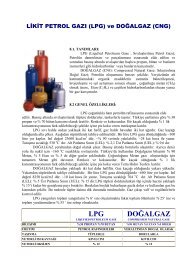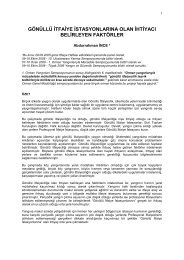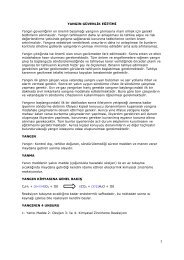buradan - Yangın
buradan - Yangın
buradan - Yangın
You also want an ePaper? Increase the reach of your titles
YUMPU automatically turns print PDFs into web optimized ePapers that Google loves.
TÜYAK BİLDİRİLER KİTABI<br />
2009 PROCEEDINGS BOOK<br />
fire are untouched by the fire. Imagine the destruction if this was a<br />
full warehouse allowed to burn uncontrolled. Remember that this<br />
test was terminated after only 100 seconds.<br />
This test is a perfect demonstration of why full scale fire tests are<br />
necessary. The client’s consultant had done many calculations and<br />
was confident the protection scheme would work but the only way<br />
to be sure is to run a test. Although the test was not cheap it did<br />
prevent an inadequate system from being installed preventing a<br />
potentially much more costly system failure in the real warehouse.<br />
Sprinkler Used In Warehouse<br />
Figure 16. Heat sensitive element in a sprinkler<br />
The sprinklers are installed on pipes which are filled with water<br />
ready and waiting to attack the fire. Each sprinkler has its own heat<br />
sensitive element, a glass bulb or fusible metal link, fixed into the<br />
sprinkler and which holds back the water.<br />
To ensure the sprinkler will not leak 100% of sprinklers are<br />
rigorously tested at pressures well in excess of those they will see<br />
in service.<br />
Figure 17. A specific temparature is needed to start up individual operation<br />
of each sprinkler<br />
This heat sensitive element will ONLY operate when it reaches<br />
a specific temperature with heat from the fire. This means that<br />
only those sprinklers heated up by the fire will operate – not every<br />
sprinkler in the room as often seen on the TV or in movies. They<br />
are not operated by smoke – unless it is accompanied by heat<br />
from a fire!<br />
Figure 18. Water release and distribution of a sprinkler<br />
Once the sprinkler operates the water immediately starts to flow<br />
out from the sprinkler, hitting a deflector which distributes the<br />
water over the fire. As only the sprinklers near the fire operate the<br />
minimum amount of water is used to control the fire. In fact in over<br />
90% of fires in sprinklered buildings are controlled with 4 or fewer<br />
sprinklers.<br />
w Installed at the ceiling<br />
w Installed in racks for very storage<br />
6<br />
TÜYAK 2009<br />
w Attack the fire directly<br />
w Also pre-wet goods around the fire to slow the fire down<br />
Figure 19. Typical installation of sprinkler for racks<br />
We have seen that the fire risk in warehouses is severe and in<br />
order to address that risk the sprinkler<br />
system must be designed with all the aspects such as the type of<br />
goods, storage height etc into<br />
account.<br />
As in all sprinkler systems there are sprinklers installed at the<br />
ceiling. With ceiling sprinklers you can protect many warehouse<br />
occupancies, the height will vary on the type of goods and how you<br />
store them but can typically be up to 6 or 7m.<br />
Once you go above these heights you are required to start installing<br />
sprinklers inside the racking. These ‘in-rack’ sprinklers effectively<br />
bring the level of the ceiling down ensuring fast operation and<br />
direct water delivery to the fire. A network of pipes is installed in the<br />
central flue of the rack and sprinklers installed on the pipes. These<br />
in-rack sprinklers must be protected from accidental damage with<br />
guards and also with water shields to prevent water from above<br />
cooling down the sprinkler and preventing it from operating.<br />
Sprinklers used in warehouses operate very quickly, typically in a<br />
full scale test at 13m they may operate only 40-60 seconds after<br />
ignition. The sprinklers work in two main ways to control the fire:<br />
w Water from the sprinkler will travel down the racking and start to<br />
attack the fire directly. The level of control of the fire will depend<br />
on the fire growth, the racking structure and the amount of water<br />
delivered – called the water density. The more risky the fire, the<br />
higher the water density which is applied. For example for a<br />
storage of mattresses on racks to 6m height and protected only<br />
from the ceiling the sprinklers will deliver 17.5 litres per minute to<br />
each square meter of the fire.<br />
w The sprinkler will also spray water onto the goods surrounding<br />
the fire. This slows down the progress of the fire.<br />
It is important to note that although in many cases the sprinklers<br />
will reduce the fire size and may even extinguish it, the fire service<br />
are very much needed to enter the building and ensure the fire<br />
is completely extinguished. All sprinkler systems can provide an<br />
electrical alarm which can be automatically forwarded to the fire<br />
service control centre.





